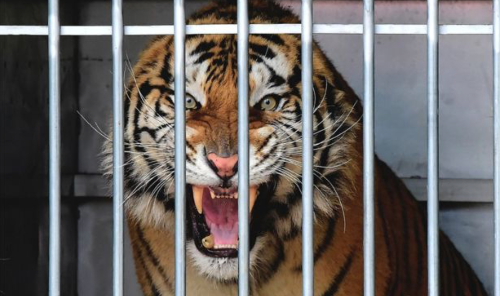Tigers at the BBC – Part 2
24 March 2020
The inner sanctum of the tigers was a maze of cages with a narrow galley connecting them. Caretakers stood in the galley when checking or interacting with the animals. Three large spaces, separated by steel rods had a door at one end of each cage. The doors were levered open by automated switches to allow each tiger access to their outdoor enclosure.
Since tigers are solitary animals, their internal as well as external habitats in the zoo gave them enough room to move, have privacy in specifically created dark nooks along with some space to socialise on the occasions they wanted to groom each other or play fight. Each of the three tigers had a trough of water and a thick layer of hay on which to rest. The overpowering musk in the air, combined with my abject fear and fascination made the place reek. I controlled the urge to throw up.
Before I entered the enclosure’s galley I was given explicit instructions:
Stay two feet away from the steel bars.
Keep the mic by my side when recording and not front and centre. The tiger might believe it to be some sort of threat.
No sudden movements.
No sudden sounds.
Be mindful of the scraping my shoes made against the concrete floor – it was best to tip toe.
In the first few seconds it took my eyes to adjust to the low light inside, I only saw empty cages. Two of them rightly so since the females were luxuriating in the spring sun outside. But I heard him before I saw him.
The pacing, the breathing. More like heavy sniffing. I was a new scent. And there he was, coming toward the front of his cage, in quiet curiosity. A massive tiger, yellow eyes and orange stripes aflame, all sinews and muscles. I nearly shat myself.
All that separated us was some metal tubing (which did not look strong enough against this animal’s character). It nearly melted into the tiger’s body, creating some sort of optical illusion as he paced, nose in the air, a menace dancing between each stride. So far, the microphone, assiduously hanging on to my sweating palm despite the loosening grip, had captured nothing.
In a radio documentary the only sense to which the audience can connect, is the sense of sound. The other senses – smell, sight, touch and taste – are aroused by taking the listener through each one by telling them about it or by making them hear it. The radio listener will salivate when told about the delicious pastry being prepared in a kitchen or feel cold with sounds of a thunderstorm within the documentary.
I needed my listener to understand the magnitude of what I was looking at in front of me. I needed my listener to be as frightened and as awed by what I was encountering in that moment. I would be able to convey the scene through my own words, but talk was not enough. I whispered to the zookeeper. I needed sounds. He nodded and touched my shoulder with one hand, a finger to his lips with his other hand. The tiger continued pacing, ravenous, annoyed with this new human getting in the way of his routine.
I watched in alarm as the courageous man next to me picked up a large stick resting in one corner of the galley. He began to move it back and forth on the steel rods of the cage in rhythm to the tiger’s steps. On and on it went, with the tiger changing his stance from slow to faster and then disappearing to the dark recesses of its cage. The zookeeper continued clanging at the cage, a dangerous xylophone.
With zero warning the tiger appeared from the darkness, a flash like a match on dry tinder. He lunged with his entire body at the bars, a deafening roar reverberating across what I thought to be the whole zoo (maybe even Regent’s park). His underbelly was stark white. Stretched out on his hind legs like that he must have been at least 10 feet tall. Within seconds of the first assault, he disappeared and launched another one, this time with more force, gathering momentum as he sped towards us. His weight made the cage rattle.
I was rooted to my spot, barely a few paces away from the reverberating mass of rage. I felt fear leave me in that instant. I connected to the deepest part of his energy which was so unhinged, so visceral. He nor I knew what the other was doing in that moment, just that we were doing it – we were both present, everything else around us stopped being.
It lasted perhaps five seconds before the zookeeper brought his hand to my elbow. My core returned to the place inside me it always had been previous to this encounter. We silently moved out of the galley into the fresh air and sun. I didn’t look back, I didn’t want to check if he was still there, watching us as we left his space.
I was left on my own after that, free to explore the rest of the zoo. He would now be fed his lunch, behind bars in his sanctorum. I don’t know if that memory of being teased by the zookeeper changed him in any way, made him more aware of the human propensity to rouse animals, just by the token of us being gifted with the intelligence to understand consequence. I don’t know if he made any associations of my new scent with provocation and retaliation. All I know is that instead of feeling diminished by his ferocity, I was empowered by it. Thus started by life long love for tigers.
After I graduated from journalism school, I approached the BBC World Service Radio with my documentary. It was February 1999, the Chinese year of the Tiger was just ending and I marketed my stance in the documentary as an important contemporary development vs environment debate. I was 23 years old, naive and full of youthful bluster. I fully believed in my own grandiose… yet, when the BBC bought the documentary (which lead to more jobs with them) I was shocked. Producers for the World Service’s ecological programming had me record some bit and edit some parts to suit the organisational style there, but for the most part it was intact – with the opening seconds filled with a furious tiger’s roar.
I’d like to think I had the chutzpah to launch a career at the BBC. But deep down I know it was the tiger’s dauntlessness which was the cornerstone of it all.
 0 comments
0 comments

